
Zoop is a puzzle video game originally developed by Hookstone and published by Viacom New Media in 1995 for the Genesis, Super Nintendo Entertainment System, MS-DOS, Macintosh, PlayStation, Game Gear, and Game Boy, then in 1996 for the Saturn and Jaguar. Zoop has similarities to Taito's 1989 arcade video game Plotting, but Zoop runs in real-time instead. Players are tasked with eliminating pieces that spawn from one of the sides of the screen before they reach the center of the playfield. By pointing at a piece and shooting it, the player can either swap it with the current player color and thus arrange the same color pieces in a row or column, or match the color.
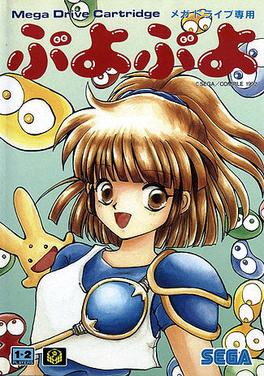
Puyo Puyo (ぷよぷよ) is a puzzle video game released in 1991 by Compile for the MSX2. Since its creation, it uses characters from Madō Monogatari. It was created by Masamitsu "Moo" Niitani, the founder of Compile, who was inspired by certain elements from the Tetris and Dr. Mario series of games.

Dr. Robotnik's Mean Bean Machine is a falling block puzzle game developed by Compile and published by Sega. It was released for the Sega Genesis / Mega Drive in North America and Europe in November 1993, and ported to the Game Gear in 1993 and Master System in 1994.
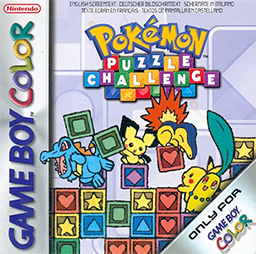
Pokémon Puzzle Challenge is a puzzle video game developed by Intelligent Systems and published by Nintendo for the Game Boy Color. Released in Japan on September 21, 2000; in North America on December 4, 2000; and in PAL regions on June 15, 2001, it is the second Pokémon-themed entry in the Puzzle League series. While its Nintendo 64 counterpart Pokémon Puzzle League is visually based on the Pokemon anime, Puzzle Challenge instead draws inspiration from the Pokémon Gold and Silver games. The game features multiple modes of play and support for competitive play between two players. Puzzle Challenge was later digitally re-released via the Nintendo 3DS's Virtual Console line on November 6, 2014.

Kirby's Avalanche, known in Europe as Kirby's Ghost Trap, is a puzzle video game developed by Compile and Banpresto and published by Nintendo for the Super Nintendo Entertainment System. It was released on February 1, 1995 in Europe and on April 25, 1995 in North America. It is a Western release of the Japanese Super Puyo Puyo featuring characters from the Kirby series. There was not a Japanese release, and the game remains the only Kirby title not released there. In Europe and Australia, the game was re-released on the Wii's Virtual Console service on July 27, 2007 and in North America on September 24, 2007. The game was re-released for the Nintendo Switch Online service on July 21, 2022.

Puyo Pop Fever is a 2003 puzzle video game developed by Sonic Team and published by Sega. It is the fifth main installment in the Puyo Puyo puzzle game series and the second Puyo Puyo game to be programmed by Sonic Team after Puyo Pop. This was the start of what can be considered a reboot of the Puyo Puyo franchise, with this entry's plot revolving around Professor Accord losing her flying cane.

Super Puzzle Fighter II Turbo, released in Japan as Super Puzzle Fighter II X, is a tile-matching puzzle video game released in 1996 for the CP System II (CPS2) arcade board, by Capcom and its Capcom Coin-Op division. The game's title is a play on Super Street Fighter II Turbo, as there were no other Puzzle Fighter games at the time, and the game includes music and interface elements spoofing the Street Fighter Alpha and Darkstalkers games. It was a response to Sega's Puyo Puyo 2 that had been sweeping the Japanese arcade scene.

Pac-Attack, also known as Pac-Panic, is a 1993 falling-tile puzzle video game developed and published by Namco for the Super Nintendo Entertainment System and Sega Genesis. Versions for the Game Boy, Game Gear and Philips CD-i were also released. The player is tasked with clearing out blocks and ghosts without them stacking to the top of the playfield — blocks can be cleared by matching them in horizontal rows, while ghosts can be cleared by placing down a Pac-Man piece that can eat them. It is the first game in the Pac-Man series to be released exclusively for home platforms.
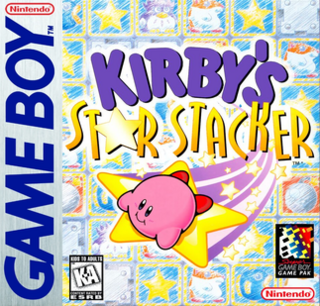
Kirby's Star Stacker is a 1997 puzzle video game developed by HAL Laboratory and published by Nintendo for the Game Boy.
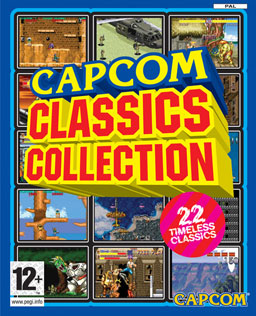
Capcom Classics Collection is a compilation of arcade games released by Capcom for the PlayStation 2 and Xbox on September 27, 2005 in North America and in 2006 in Japan. It was developed by Digital Eclipse Software, Sensory Sweep, and its Japanese developer Klein Computer Entertainment. A second volume, Capcom Classics Collection Vol. 2, was released on November 24, 2006 in North America, for PlayStation 2 and Xbox. The second volume as well as the Xbox version of the first volume were not released in Japan.

Puyo Puyo 2 is a 1994 puzzle video game developed and published by Compile. It's the second installment in the Puyo Puyo series and the sequel to Puyo Puyo (1992).

Hebereke's Popoon is a two player puzzle video game developed and published by Sunsoft. It is based on the Hebereke series. Hebereke means drunk or untrustworthy. Popoon is an onomatopoeia for the sound made by the game pieces when they explode.

Puyo Puyo! 15th Anniversary is a puzzle video game of the Puyo Puyo series, developed by Sonic Team and published by Sega for the Nintendo DS in 2006, as well as PlayStation 2, PlayStation Portable, and Wii in 2007. It has not been released outside of Japan for any consoles. This is the first Puyo Puyo game to be released on the Wii console.
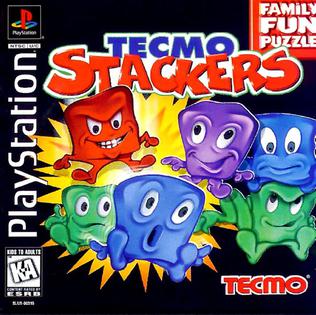
Tecmo Stackers, known as Dero~n Dero Dero (でろ~んでろでろ) in Japan, is a puzzle video game released first in 1995 by Tecmo to arcades and ported to both the Sony PlayStation and SEGA Saturn. The gameplay is similar to Puyo Puyo.
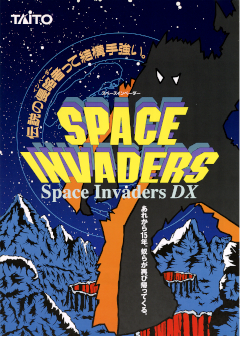
Space Invaders DX is a 1993 fixed shooter arcade game developed and published in Japan by Taito. It has been re-released for several consoles since, including the Super Nintendo Entertainment System, PC Engine Super CD, and Sega Saturn — several of these conversions use the name Space Invaders: The Original Game. The player assumes control of a laser base that must fend off waves of incoming enemies, who march down in formation towards the bottom of the screen. It is the fifth entry in the long-running Space Invaders series. DX contains four variations of the original Space Invaders, in addition to a multiplayer mode and a "Parody Mode" that replaces the characters with those from other Taito franchises. Home ports of DX received mixed reviews for their high price point and general lack of content.
Puyo Puyo (ぷよぷよ), previously known as Puyo Pop outside Japan, is a series of tile-matching video games created by Compile. Sega has owned the franchise since 1998, with games after 2001 being developed by Sonic Team. Puyo Puyo was created as a spin-off franchise to Madō Monogatari, a series of first-person dungeon crawler role-playing games by Compile from which the Puyo Puyo characters originated. The series has sold over 10 million copies, including the Madō Monogatari games.
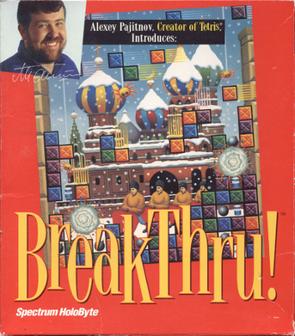
BreakThru! is a tile-matching puzzle video game released for Windows and MS-DOS in 1994. It was created by Steve Fry for the Japanese company ZOO Corporation and published by Spectrum HoloByte for the North American market.

Puyo Puyo Tetris is a 2014 puzzle video game developed by Sonic Team and published by Sega. The game is a crossover between the Puyo Puyo series and the Tetris franchise, and features various gameplay modes incorporating both aspects. The game includes characters modeled and named after the seven Tetrominos, which are different puzzle pieces each made of four blocks.

Cosmo Gang the Puzzle is a 1992 falling block puzzle arcade video game developed and published by Namco worldwide. The third game in its Cosmo Gang series, succeeding that year's Cosmo Gang the Video, players stack groups of blocks and aliens known as Jammers in a vertical-oriented well. The objective is to clear as many objects on the screen before they reach the top of the screen. Blocks are cleared by aligning them into complete horizontal rows, while Jammers are cleared by defeating them with blue-colored spheres.
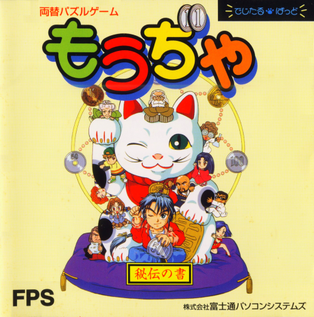
Moujiya or Ryougae Puzzle Mouja is a falling blocks puzzle video game from Fujitsu Pasocom Systems, the consumer software division of Fujitsu. Initially developed for computers running Windows 3.11 and above, it later got made into an arcade video game, which itself was ported to popular home consoles of the time.




















